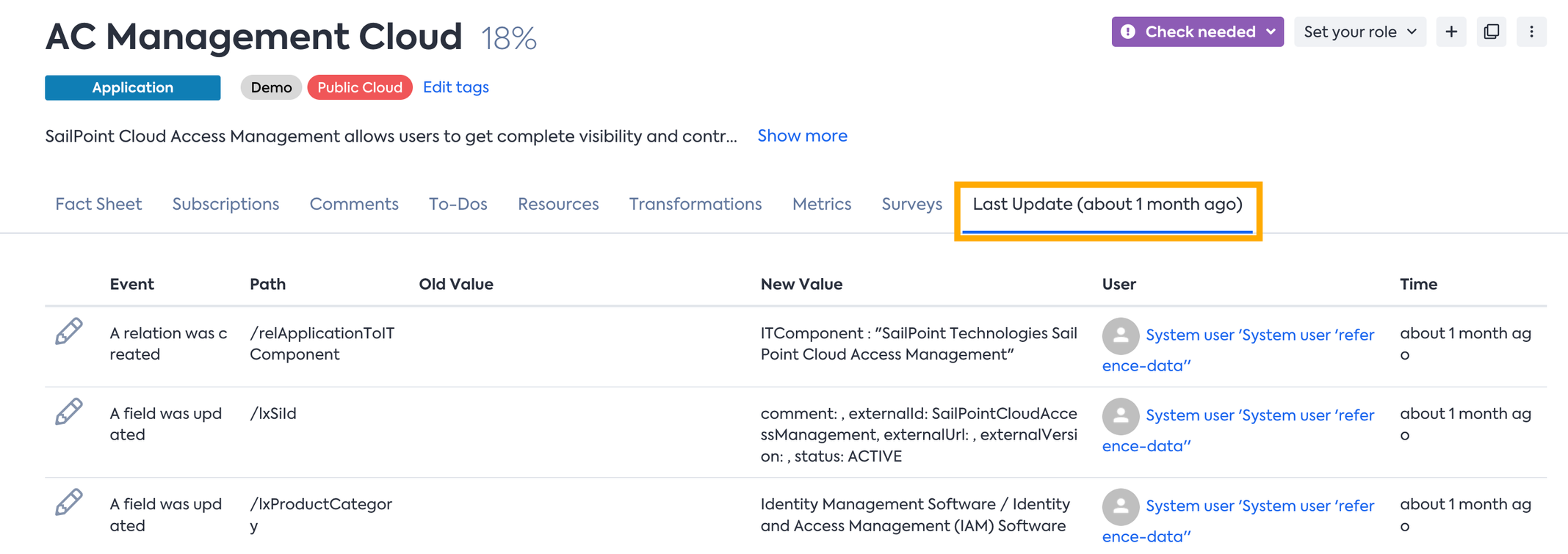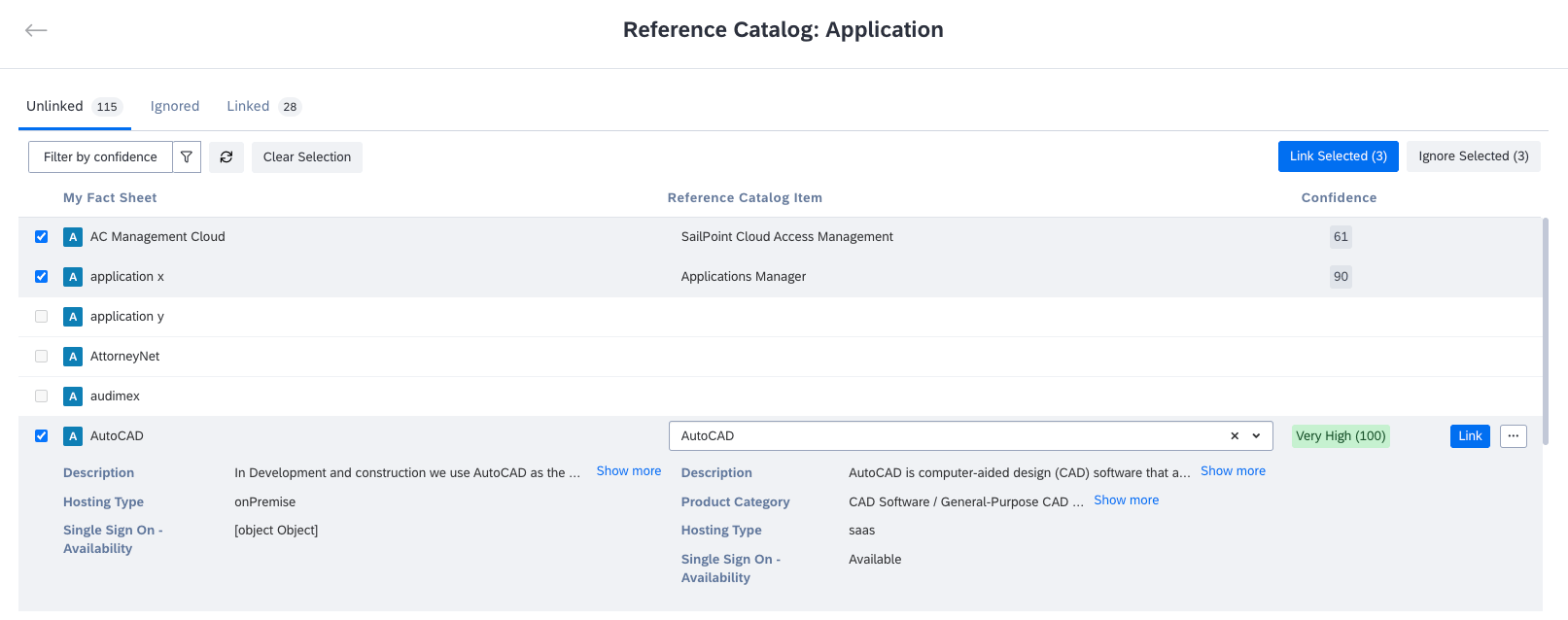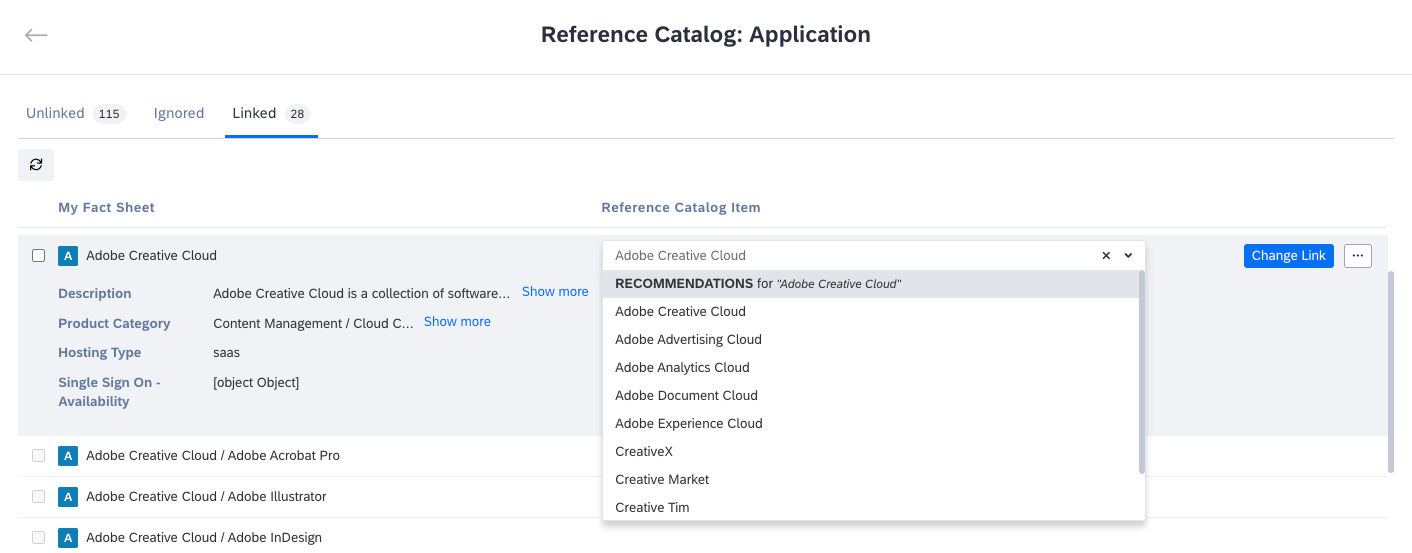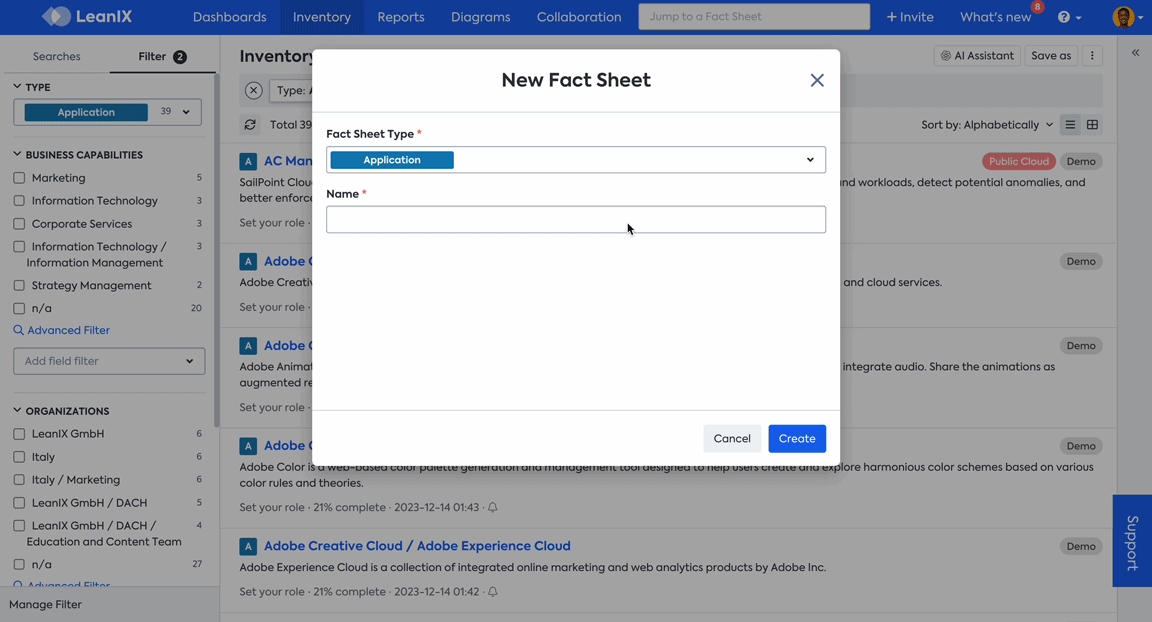Applications in the Reference Catalog
By using reference data for application fact sheets, you can increase standardization and data quality, as well as set relations to other fact sheets for best-practice modeling.
Overview
The reference catalog offers standardized data for application fact sheets, simplifying the procedure of documenting applications within SAP LeanIX. To learn more about which applications are included in the catalog, see Scope of Applications in the Reference Catalog.
You can configure which data fields you want to sync with the catalog. Once a fact sheet is linked to the catalog, this information is automatically synced and updated on relevant application fact sheets. Additionally, you can set relations to IT components, which enables you to enrich and automatically complete your portfolio.
Benefits
By using catalog data for application fact sheets, you can:
- Enhance fact sheet standardization: With catalog data, you can establish better naming standardization across fact sheets and avoid duplication if you used multiple methods to populate your inventory.
- Increase fact sheet quality: With catalog data, you can enrich required fact sheet fields, helping users to complete fact sheet information with less effort.
- Maintain up-to-date data: Once application fact sheets are linked to the catalog, the information from the catalog is automatically synced and updated whenever there is a change in the catalog's data. You can select which attributes you want to sync with the catalog.
- Set relations for best-practice fact sheet modeling: Linking an application to a catalog item can automatically establish relations between fact sheets where the relation is explicit (for example, between SaaS applications and SaaS Hosting IT components). For relations to be set properly, some fact sheets should already exist in the inventory. If they don’t, the catalog creates related fact sheets. This enables you to get the most out of catalog data without impacting the fundamental model.
Scope of Applications in the Reference Catalog
In this section, you can find an overview of the catalog’s scope for application items.
Note
SAP LeanIX reserves the right to change the scope of the catalog at any given time.
Applications in Scope
The current scope of the catalog focuses on items that are defined as SaaS applications.
A SaaS (Software as a Service) application is a software delivered on-demand and ready to use over the internet. It serves customers without having to install the software on individual systems or on-premise servers. Authorized users can access SaaS applications from anywhere on any authorized device.
The following attributes help to identify if an application is SaaS or not. A SaaS application:
- Is available online and ready to use
- Is licensed based on a subscription, for free, or pay-as-you-go model
- Requires a login to get access
- Is accessible from different devices (for example, desktop computers and mobile devices)
- Is hosted centrally in the cloud
- Doesn't require a dedicated infrastructure from the client
Additionally, SAP products (regardless of hosting type) are included in the catalog’s scope.
Applications Out of Scope
The following applications are out of scope:
- B2C SaaS applications (for example, Duolingo, Netflix, Spotify)
- Desktop client and on-premise server applications (for example, Adobe Photoshop, Microsoft Office client applications for Windows and MacOS, Slack Desktop Client, VMWare Workstation Pro)
- Websites, which are primarily focusing on B2C or which are solely used to provide information without functionally which allows them to be embedded in other applications (for example, Amazon, eBay, Facebook).
- Plug-ins and add-ons for platforms (for example, browser extensions, marketplace apps, Atlassian Confluence plug-ins), except for major plug-ins and add-ons of top vendors
- Mobile applications (for example, Slack for mobile, Microsoft Outlook for mobile)
Note
We recommend modeling IaaS and PaaS applications as IT component fact sheets, and hence, these components are classified as IT components in the reference catalog.
Configuring Settings for Syncing Fields and Establishing Relations
As an admin, you can configure how to use catalog data for application fact sheets. Follow these steps:
- In the administration area, navigate to the Reference Catalog section, then go to the Application tab.
- Select the data fields that you want to sync from the catalog.
- Choose whether you want to set relations to IT components. If you select this option, you can also enable setting relations to providers and tech categories related to IT components.
- Click Save.
Linking Applications to Catalog Items
Note
Both admins and members can manage how fact sheets are linked to catalog items, which includes establishing links, ignoring fact sheets, and modifying existing links. Viewers don't have access to the reference catalog.
When a fact sheet is linked to a catalog item, the attributes selected by the admin are automatically synced with the catalog and regularly updated.
There are three ways to link fact sheets to the catalog:
- Bulk linking fact sheets from the inventory
- Linking individual fact sheets from the fact sheet page
- Linking a fact sheet during fact sheet creation
On the Last Update tab of the fact sheet page, you can check any updates made to the linked fact sheet as a result of syncing. Updates are attributed to the System user ‘reference data’ user.

Checking Updates in the Last Update section of the Fact Sheet
Bulk Linking Application Fact Sheets from the Inventory
To manage linking to catalog items for multiple fact sheets, navigate to the reference catalog page from the inventory. This allows you to preview recommendations for multiple fact sheets, establish links, ignore certain items, and modify existing linked items, all in one location.
To link multiple fact sheets at once, do the following:
- In the inventory, apply filters to refine the list of fact sheets as per your needs.
- On the right-side pane, click Application Linking under Reference Catalog. On the catalog page that appears, fact sheets are arranged into different tabs based on whether they're unlinked, ignored, or linked.
- On the Unlinked tab, select a fact sheet, select a relevant catalog item to link to, then click Link.
You can bulk link fact sheets for which recommended items are provided. To do that, select fact sheets, then click Link Selected.

Linking Fact Sheets to Catalog Items in Bulk
Note
The displayed list of applications is based on the filters you applied in the inventory.
The Confidence column on the right provides an intelligent recommendation indicating the match level between the fact sheet and the catalog item. If you want to focus on fact sheets with very high or high confidence levels, you can use the Filter by confidence option located in the upper-left corner.
The confidence level score is calculated based on the matches between the fact sheet display name and the catalog item name. The confidence levels are categorized as follows:
- Very high (100)
- High (96–99)
- Other, displayed without a text label (below 96)
By expanding each row, you can view a summary of the fact sheet and details of the corresponding catalog item recommendation. If the recommendation doesn't align with your needs, use the search field to find a specific item to link to. You can link, preview, or ignore individual fact sheets in each row.
Ignoring Application Fact Sheets
You can ignore a fact sheet if you don't want to link it to any catalog item. The fact sheet is moved to the Ignored tab. If needed, you can link ignored fact sheets to catalog items later.
Reasons to ignore include:
- It is a proprietary product, and you do not expect the catalog to have information about it.
- You want to overwrite the information in the linked fact sheet. Ignoring a linked fact sheet effectively unlinks the fact sheet and stops updates from the catalog.
If you used a filter in the inventory, you can ignore multiple fact sheets in bulk on the Unlinked tab. To do that, select fact sheets, then click Ignore Selected. When the Filter by confidence filter is applied, the option to bulk ignore fact sheets is not available.
Note
Ignoring a linked fact sheet halts updates from the reference catalog.
Changing the Link to a Different Item
You can link a fact sheet to a different catalog item if there is a more appropriate one or if it was inadvertently linked to the current item. Follow these steps:
- On the reference catalog page, navigate to the Linked tab.
- Select a fact sheet, click on the search field to see alternate recommendations or to search for a specific item to change to.
- Choose the appropriate recommendation you want to change to, and click Change Link.

Changing the Link to a Different Item
Linking an Application Fact Sheet from the Fact Sheet Page
Follow these steps:
- Open an application fact sheet.
- On the right-side panel, under Reference Catalog, click Link Now. The catalog page opens with relevant recommendations for that fact sheet.
- Choose the catalog item to link or search for a specific item to link from the search bar, then click Link.

Linking a Fact Sheet to a Catalog Item from the Fact Sheet Page
Linking an Application Fact Sheet During Fact Sheet Creation
You can link an application to a catalog item from the fact sheet creation overlay. Follow these steps:
- Enter the name of the application in the fact sheet creation overlay. As you type the name, recommendations from the reference catalog appear below the input field.
- Choose the appropriate catalog item, then click Create & Link.

Linking Application Fact Sheet During Fact Sheet Creation
Linking Multiple Applications to the Same Catalog Item
When configuring synchronization settings, selecting the Name field for syncing prevents linking multiple fact sheets to the same catalog item. This helps avoid duplicates and name conflicts in workspaces.
However, there are scenarios where linking multiple fact sheets to the same catalog item is needed. For example, when the same SaaS application is used by different organizations for distinct business capabilities or when the same SaaS application is used in different environments for varied purposes. Users often need to model these multiple instances of the same application to bring transparency.
To link multiple application fact sheets to the same catalog item, exclude the Name field from syncing in the catalog settings.
If you prefer to sync the Name field and still want to link multiple fact sheets, a workaround involves creating an abstract parent fact sheet and linking it to the catalog item. Then, model all instances of the same application as child fact sheets under this parent instance.
Aligned Catalog Items: Applications and IT Components
In the catalog settings for applications, you can enable the automated creation of relations to IT components (as well as relations to providers and tech categories for IT components). This enables you to enrich and automatically complete your portfolio. This alignment ensures there are no duplications if you’re using both applications and IT components from the catalog.
If you've enabled the linking of applications to IT components in the catalog settings, when a SaaS application is linked to a catalog item, the associated SaaS hosting IT component fact sheet is automatically created and linked to the catalog. In this context, SaaS hosting means that an application is hosted as a SaaS product.
Updated 4 months ago
